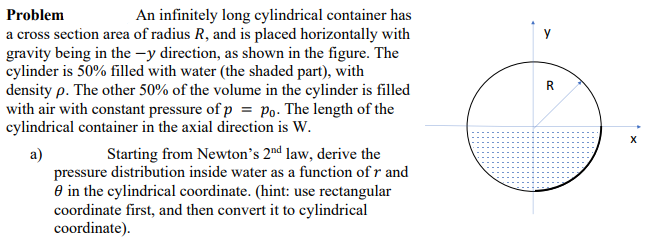Problem An infinitely long cylindrical container has a cross section area of radius R, and is placed horizontally with gravity being in the -y direction, as shown in the figure. The cylinder is 50% filled with water (the shaded part), with density p. The other 50% of the volume in the cylinder is filled with air with constant pressure of p = Po. The length of the cylindrical container in the axial direction is W. R Starting from Newton's 2nd law, derive the а) pressure distribution inside water as a function of r and O in the cylindrical coordinate. (hint: use rectangular coordinate first, and then convert it to cylindrical coordinate).
Problem An infinitely long cylindrical container has a cross section area of radius R, and is placed horizontally with gravity being in the -y direction, as shown in the figure. The cylinder is 50% filled with water (the shaded part), with density p. The other 50% of the volume in the cylinder is filled with air with constant pressure of p = Po. The length of the cylindrical container in the axial direction is W. R Starting from Newton's 2nd law, derive the а) pressure distribution inside water as a function of r and O in the cylindrical coordinate. (hint: use rectangular coordinate first, and then convert it to cylindrical coordinate).
Elements Of Electromagnetics
7th Edition
ISBN:9780190698614
Author:Sadiku, Matthew N. O.
Publisher:Sadiku, Matthew N. O.
ChapterMA: Math Assessment
Section: Chapter Questions
Problem 1.1MA
Related questions
Question

Transcribed Image Text:Problem
An infinitely long cylindrical container has
a cross section area of radius R, and is placed horizontally with
gravity being in the -y direction, as shown in the figure. The
cylinder is 50% filled with water (the shaded part), with
density p. The other 50% of the volume in the cylinder is filled
with air with constant pressure of p = po. The length of the
cylindrical container in the axial direction is W.
R
Starting from Newton's 2nd law, derive the
а)
pressure distribution inside water as a function of r and
O in the cylindrical coordinate. (hint: use rectangular
coordinate first, and then convert it to cylindrical
coordinate).
Expert Solution
This question has been solved!
Explore an expertly crafted, step-by-step solution for a thorough understanding of key concepts.
This is a popular solution!
Trending now
This is a popular solution!
Step by step
Solved in 2 steps with 1 images

Knowledge Booster
Learn more about
Need a deep-dive on the concept behind this application? Look no further. Learn more about this topic, mechanical-engineering and related others by exploring similar questions and additional content below.Recommended textbooks for you

Elements Of Electromagnetics
Mechanical Engineering
ISBN:
9780190698614
Author:
Sadiku, Matthew N. O.
Publisher:
Oxford University Press

Mechanics of Materials (10th Edition)
Mechanical Engineering
ISBN:
9780134319650
Author:
Russell C. Hibbeler
Publisher:
PEARSON

Thermodynamics: An Engineering Approach
Mechanical Engineering
ISBN:
9781259822674
Author:
Yunus A. Cengel Dr., Michael A. Boles
Publisher:
McGraw-Hill Education

Elements Of Electromagnetics
Mechanical Engineering
ISBN:
9780190698614
Author:
Sadiku, Matthew N. O.
Publisher:
Oxford University Press

Mechanics of Materials (10th Edition)
Mechanical Engineering
ISBN:
9780134319650
Author:
Russell C. Hibbeler
Publisher:
PEARSON

Thermodynamics: An Engineering Approach
Mechanical Engineering
ISBN:
9781259822674
Author:
Yunus A. Cengel Dr., Michael A. Boles
Publisher:
McGraw-Hill Education

Control Systems Engineering
Mechanical Engineering
ISBN:
9781118170519
Author:
Norman S. Nise
Publisher:
WILEY

Mechanics of Materials (MindTap Course List)
Mechanical Engineering
ISBN:
9781337093347
Author:
Barry J. Goodno, James M. Gere
Publisher:
Cengage Learning

Engineering Mechanics: Statics
Mechanical Engineering
ISBN:
9781118807330
Author:
James L. Meriam, L. G. Kraige, J. N. Bolton
Publisher:
WILEY